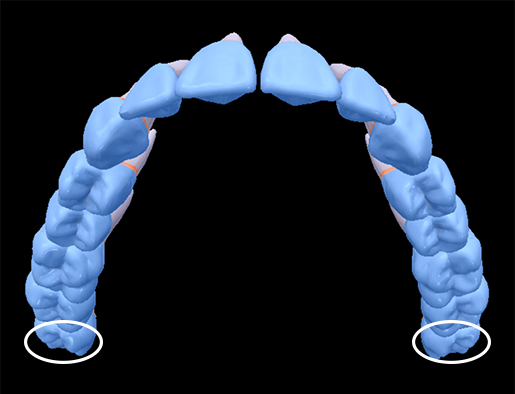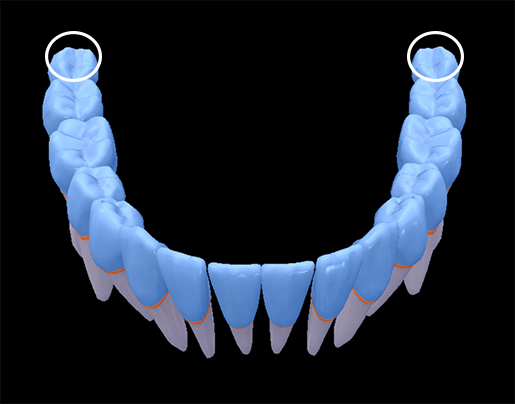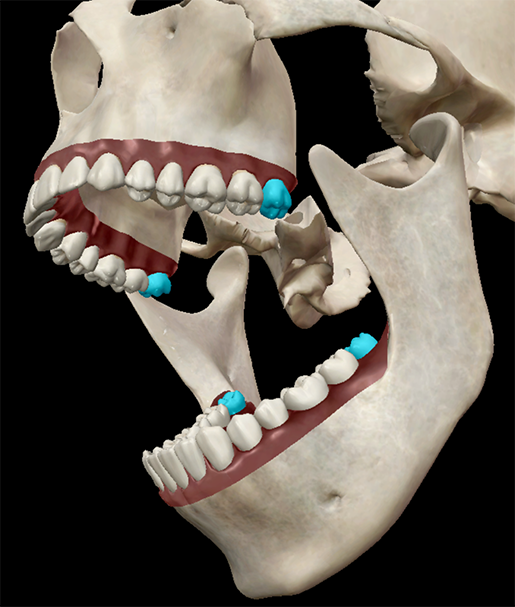Wise Up! Three "Whys" of Wisdom Teeth
Posted on 4/22/19 by Laura Snider
Wisdom teeth may sound mystical, but all they are is the third set of molars (the large back teeth that grind up our food). They are the last set of molars to grow in, usually showing up between the ages of 17 and 25.
Chances are you associate them with extraction, since wisdom tooth removal is a common dental surgical procedure that many teens and young adults undergo. So let’s have a chat about these often unwelcome teeth and why, despite the fact that they can be a literal pain, they’re an interesting reflection of human history.
Why are they called wisdom teeth?

 Images from Human Anatomy Atlas.
Images from Human Anatomy Atlas.
Lots of languages call the third molars some variation on wisdom teeth: we have dents de sagesse in French, Weisheitzähne in German, ders-al-a’qel (“teeth of the mind”) in Arabic, and muelas del juicio (“teeth of judgment”) in Spanish. Most of us probably don’t think of ourselves as having been particularly wise during our teenage or college years, but teenagers are approaching adulthood, so even if they haven’t already attained wisdom, they’re on their way to acquiring it through experience.
Other names for the third molars are centered around various aspects of becoming more mature. In Korean, they’re called “love teeth” (sa-rang-nee) because they come in at the age when many young people experience love (and the pain of first love) for the first time. Wisdom teeth are called oyashirazu (“unknown to the parents”) in Japanese, because these teeth appear at a time when young people move out of their parents’ home. Turkish gets literal and calls them 20th-year teeth (yirmi yaş dişleri).
So, whether they’re “wisdom teeth” or “love teeth” or teeth that are “unknown to parents,” the development of third molars is regarded across languages and cultures as a marker of growing older. Pretty cool, huh?
Why do we have them?
If so many people have to get their wisdom teeth removed, why do we have them in the first place? The short answer is that you don’t need them to function in the modern world. Back in the day, though, our ancestors ate raw meat and fibrous plants, and they needed more molars to grind up all that tough material.
Fortunately for those of us who don’t enjoy raw meat, human cultures have come up with a ton of amazing and delicious ways to cook and prepare food. Cooking makes many types of food easier to eat and digest in addition to unlocking its full caloric potential. (It also makes great TV.)
While our jaws adapted as a result of these changes in our diet, becoming less broad, our number of teeth remained constant. So now lots of people have too many teeth and not enough space to accommodate them all.
I say “lots of people” instead of “everyone” because some people’s wisdom teeth just grow in without problems, so they don’t have to have them taken out, and other people (actually, about a third of the world’s population) don’t get any wisdom teeth at all.
 Our 3D models are lucky and have room for all their wisdom teeth! Image from Human Anatomy Atlas.
Our 3D models are lucky and have room for all their wisdom teeth! Image from Human Anatomy Atlas.
It’s totally normal to have fewer than four wisdom teeth, too—I remember my dentist telling me that I had only three wisdom teeth...but they’d need to come out because they’d mess with my other teeth if they grew in all the way.
That brings us to the third “why” of wisdom teeth...
Why are they removed?
When dentists perform routine x-rays on their adolescent and young adult patients, they take a look at how the wisdom teeth are growing in: if the wisdom teeth are going to be a problem (like if they’re growing in sideways and will become impacted), removing them is usually recommended.
With our smaller modern jaws, it’s not unusual for a wisdom tooth to be impacted, or trapped in the jaw. A wisdom tooth that develops but stays beneath the gum is fully impacted, and a wisdom tooth that is able to erupt partially from the gum is partially impacted. A fully or partially impacted wisdom tooth is likely growing in at a weird angle, and it can cause pain and swelling by pushing on the other molars. It can even damage their roots. Partially erupted wisdom teeth are also difficult to clean, which can lead to tooth decay or gum disease. A cyst can form around a fully impacted wisdom tooth.
Basically, there’s a lot that can go wrong where wisdom teeth are concerned. I can tell you from firsthand experience that having your wisdom teeth removed is not a particularly fun time (it’s a surgical procedure, after all), but a couple of days with a sore mouth and a puffy face is definitely better than having impacted wisdom teeth hanging out in your mouth.
Even if a wisdom tooth grows in and isn’t impacted, it’s important to maintain good dental hygiene and check in with a dentist to make sure everything’s okay back there.
Be sure to subscribe to the Visible Body Blog for more anatomy awesomeness!
Are you a professor (or know someone who is)? We have awesome visuals and resources for your anatomy and physiology course! Learn more here.
Additional Sources:






